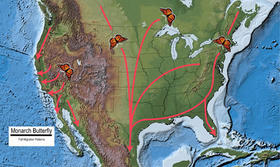A Popular Plant Meant To Help Monarch Butterflies Can Hurt Them

Monarch butterflies are declining. They migrate from the U.S. and Canada down to Mexico and are losing habitat at both ends of that migration. The U.S. Fish and Wildlife Service is considering protecting them under the Endangered Species Act.
In the meantime, people have been trying to step in and help by planting milkweed in their gardens to replace some of that habitat. Now a new study finds that the milkweed people are planting isn’t always so helpful.
Instead of completing their migration down to Mexico, some monarchs are sticking around coastal areas, scientists found. It turns out, skipping the migration is making a lot of those butterflies sick.
Dara Satterfield, an ecology graduate student at University of Georgia, asked gardeners to send in samples from butterflies. The gardeners would stick a sticker to the butterfly’s body, then send the sticker to her lab. (It doesn’t hurt the butterfly, she said.)
“I was just surprised that when I opened up the envelopes from people who have year-round butterflies, it was just infected after infected sample,” Satterfield said. “And that was a sad thing to have to report to gardeners, we’d have to say, ‘100 percent of your monarchs from your yard were infected with this protozoan parasite.’”
The parasite, called Ophryocystis elektroscirrha, can make it hard for butterflies to fly and even kill them. It occurs naturally, but it’s affecting a high proportion of the butterflies that don’t migrate.
And that brings us back to the milkweed. There are dozens of different kinds of milkweed; some are native to the Southeast, but not all. One of the more popular milkweeds sold in garden centers, Satterfield said, is tropical milkweed. Unlike the native milkweeds, tropical milkweed doesn’t die in the winter when it grows along the coast. (Here in Atlanta, it often does die back.) Since it’s still flowering, the butterflies stay put and so do the parasites.

There are two results of that, explained Satterfield. One is the parasite doesn’t go away, so there’s just more of it around. The other is, as it turns out, that migration is actually healthier for the species: Weak butterflies are weeded out, so only the strong survive.
“This piece of more monarchs not migrating and more monarchs getting sick in these locations is probably a larger piece of the puzzle explaining the decline than we’d thought about in the past,” Satterfield said.
There are easy enough solutions, she said: Plant native milkweeds, or cut tropical milkweed back in the winter so the butterflies have to move on.
“We’re really grateful to the gardeners who are planting milkweeds,” she said. “Monarchs are really going to depend on that if we want their numbers to spring back up. We just need them to be the right kind.”
9(MDAxODM0MDY4MDEyMTY4NDA3MzI3YjkzMw004))






